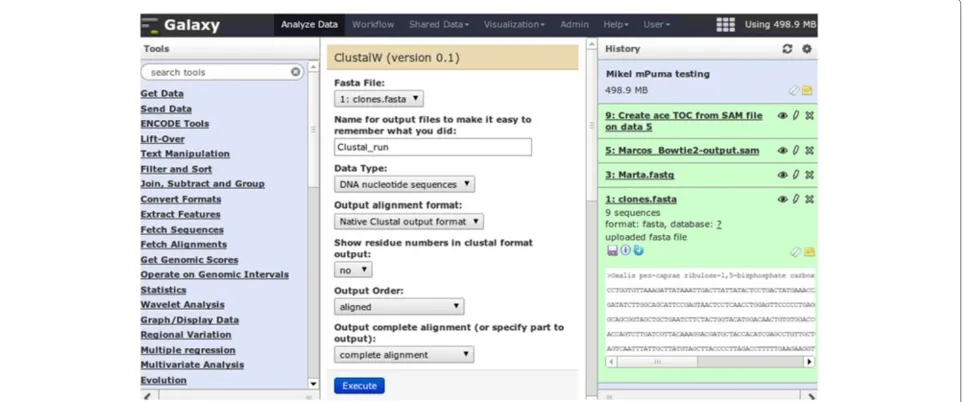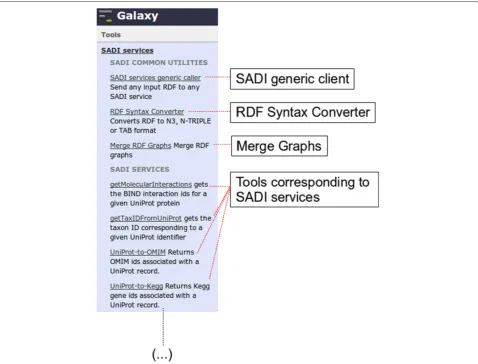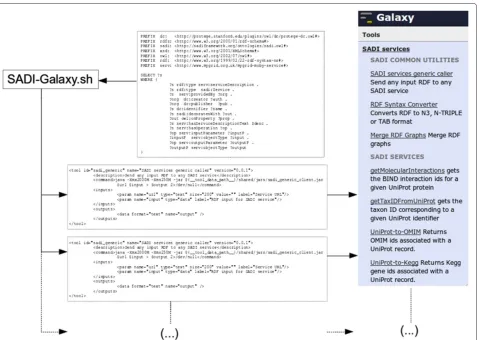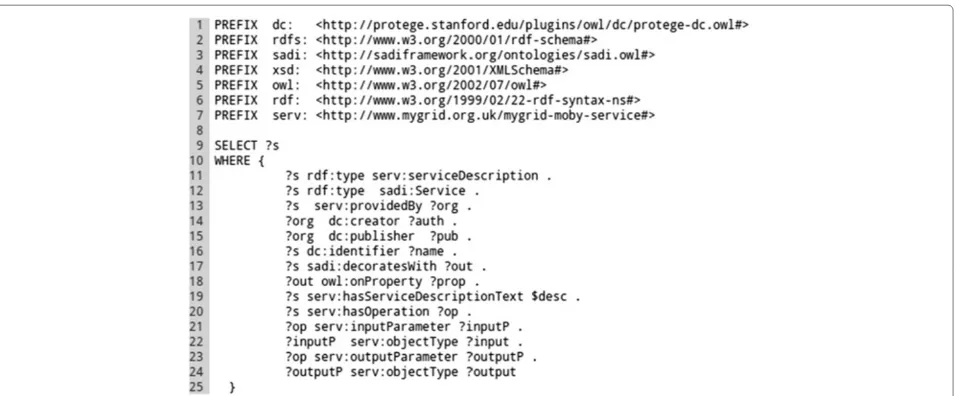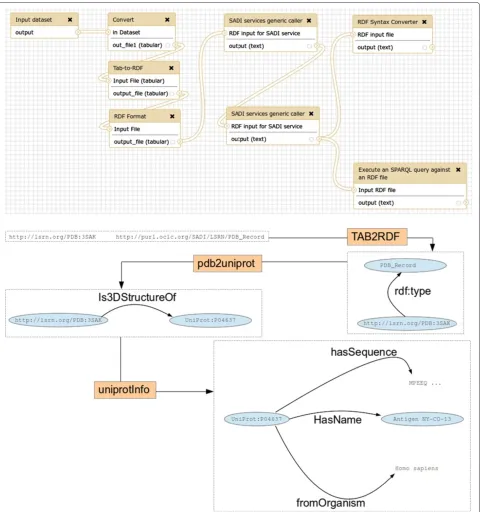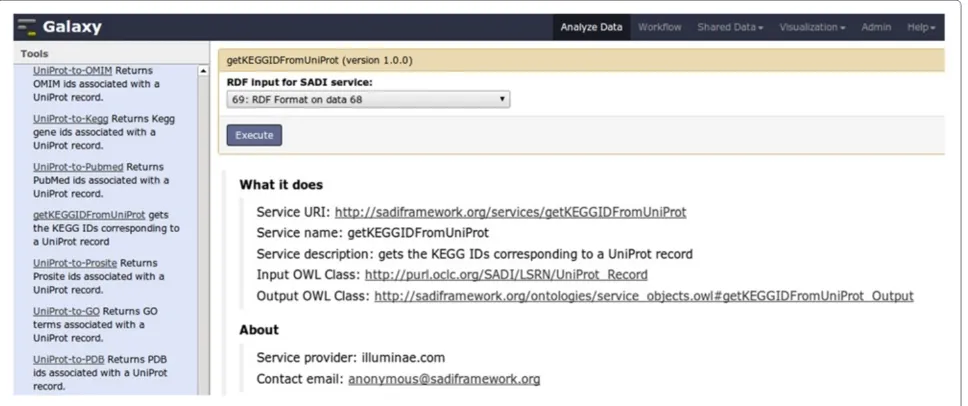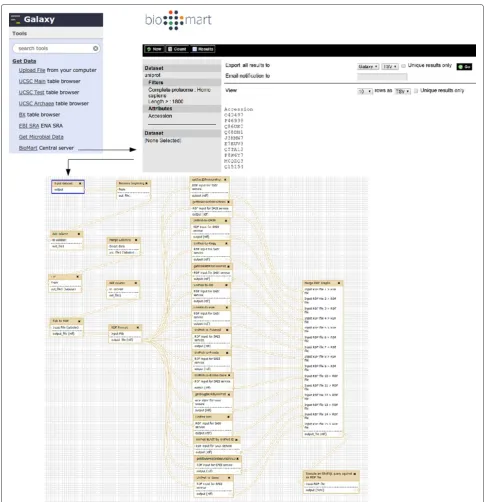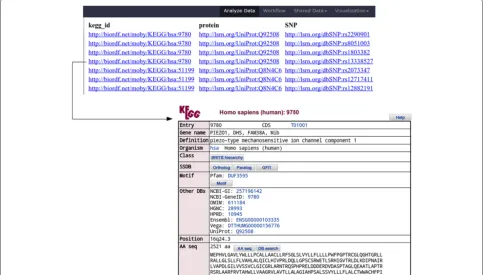S O F T W A R E
Open Access
Executing SADI services in Galaxy
Mikel Egaña Aranguren
1,2*, Alejandro Rodríguez González
1and Mark D Wilkinson
1Abstract
Background: In recent years Galaxy has become a popular workflow management system in bioinformatics, due to its ease of installation, use and extension. The availability of Semantic Web-oriented tools in Galaxy, however, is limited. This is also the case for Semantic Web Services such as those provided by the SADI project,i.e.services that consume and produce RDF. Here we present SADI-Galaxy, a tool generator that deploys selected SADI Services as typical Galaxy tools.
Results: SADI-Galaxy is a Galaxy tool generator: through SADI-Galaxy, any SADI-compliant service becomes a Galaxy tool that can participate in other out-standing features of Galaxy such as data storage, history, workflow creation, and publication. Galaxy can also be used to execute and combine SADI services as it does with other Galaxy tools. Finally, we have semi-automated the packing and unpacking of data into RDF such that other Galaxy tools can easily be combined with SADI services, plugging the rich SADI Semantic Web Service environment into the popular Galaxy ecosystem.
Conclusions: SADI-Galaxy bridges the gap between Galaxy, an easy to use but “static” workflow system with a wide user-base, and SADI, a sophisticated, semantic, discovery-based framework for Web Services, thus benefiting both user communities.
Keywords: Galaxy, Web services, SADI, RDF, SPARQL, OWL
Background
There is a growing global movement towards representa-tion of bioinformatics data and knowledge using contem-porary syntaxes and semantic languages approved by the World Wide Web Consortium (W3C) [1], like Resource Description Framework (RDF) [2] and Web Ontology Language (OWL) [3]. Major bioinformatics resources making their data available using these formats include UniProt [4], EBI [5], and soon, the DNA Databank of Japan [6]. Beyond these core providers, there are also large integrated warehouses of bioinformatics data in RDF format including, most significantly, Bio2RDF [7], which integrates critical bioinformatics resources such as dbSNP [8], OMIM [9], and KEGG [10], and NCBI eutils
*Correspondence: mikel.egana@ehu.es
1Biological Informatics, Centre for Plant Biotechnology and Genomics (CBGP), Technical University of Madrid (UPM), Campus of Montegancedo, 28223 Pozuelo de Alarcón, Spain
2Genomic Resources, Department of Genetics, Physical Anthropology and Animal Physiology, Faculty of Science and Technology, University of Basque Country (UPV/EHU), Sarriena auzoa z/g, 48940 Leioa - Bilbo, Spain
[11], which wraps NCBI databases as resolvable RDF resources.
This wealth of resources brings the inevitable require-ment for tools that support the flow of native RDF data through a formal bioinformatics analysis pipeline. The Semantic Automated Discovery and Integration (SADI) project has established design-patterns for bioinformatics resources that wish to natively consume and produce RDF data [12], and there are SADI plug-ins to several popular data workflow and exploration environments, including Taverna [13] and the IO Informatics Sentient Knowledge Explorer [14]. While Taverna is a rich and full-featured environment for constructing and editing complex work-flows, Galaxy [15] is showing itself to be a favorite of bench-biologists due to its relative simplicity compared to Taverna, and the “familiarity” it brings biologists by exposing the tools they commonly use in a manner that they can quickly interpret and work with. As such, it was desirable to bring support for SADI-based, RDF-native data and analysis tools into the Galaxy environment. Here we describe SADI-Galaxy - a set of tools that retrieve and
“wrap” SADI Semantic Web Services in a manner that allows them to be included in Galaxy workflows.
Implementation
Galaxy is a Web server, written in Python, that offers a very usable interface for the typical bioinformatics com-putational analyses (Figure 1). A user can store data, and analyse it using a variety of tools, sending the out-put of one tool as inout-put to the next. This process is stored in a chronological history from which workflows can be extracted, providing an easy-to-reproduce abstrac-tion of common steps. Data, histories and workflows are Web-shareable and can be imported and exported. A Galaxy tool is, typically, a wrapper for a terminal exe-cutable program. Since such wrappers are defined by an XML file describing the inputs and outputs of the tool as well as its Web interface [16], creating Galaxy tools from pre-existing executables is not technically demanding.
SADI is a standards-compliant set of lightweight design patterns for publishing bioinformatics data and analy-sis services on the Semantic Web. It uses Semantic Web technologies at every level of the Web services “stack”. In particular, a SADI service describes its interface in OWL, and then both consumes and produces RDF data that match that OWL logical description. Finally, SADI requires that the output data is semantically connected to the input data by a meaningful relationship. As such,
workflows of SADI services output unbroken chains of RDF Linked Data [17]. SADI services are catalogued in a publicly-accessible database (registry), and queries against that database will be used in this study to find, and retrieve the interface definitions for, SADI services of interest to any given Galaxy user; the retrieved service defini-tions will become templates for the Galaxy “wrapper”, and thus the services can be accessed through these “wrappers”.
SADI-Galaxy consists of two parts (Figure 2): the “Core”, and the Tool-generator. SADI-Galaxy Core includes three Galaxy tools that are installed in the same manner as any other Galaxy tool [18], and they can be used on their own. These tools are:
• SADI generic client. This tool is able to execute any SADI service, given the service’s URI and an RDF input file that is compatible with the service. The RDF output of the service is stored as any Galaxy output. Automated reasoning is used to check if the RDF input is compliant with the SADI Service’s input OWL class;i.e. whether the RDF instance is inferred to be a member of the input OWL Class, effectively providing up-front, “low-cost” automated workflow validation.
• RDF Syntax Converter. This tool is able to convert an RDF file into a variety of formats, most importantly including Tab Separated Values (TSV) format (three columns for subject, predicate and
Figure 2SADI-Galaxy Core tools and SADI services as Galaxy tools.Galaxy “Analyze data” view (only left column shown) resulting from the installation of the SADI-Galaxy Core (SADI generic client, RDF Syntax Converter, and Merge RDF Graphs, under “SADI COMMON UTILITIES”) and a number of specific SADI services, retrieved by a SPARQL query through the SADI-Galaxy Tool-generator (Under “SADI SERVICES”; only a few shown).
object), so that non-RDF-based Galaxy tools can consume SADI’s output.
• Graph Merge. This tool is able to merge the output of different SADI services into a single RDF graph for downstream processing.
SADI-Galaxy then offers an additional, more advanced functionality through the Tool-generator (Figure 3). The Tool-generator adds the ability to query a SADI Service registry, using arbitrary query parameters, to retrieve a set of matching SADI services. These Service-specific tools will then be deployed in Galaxy, alongside the Core tools described above. The Tool-generator, at the code-level, is simply a command line executable (A Shell script) that reads one or more SPARQL [19] queries and executes them against a SADI registry. The matching service URIs retrieved by the query are then used to generate, for each
service, a Galaxy compliant wrapper and install it as a new Tool.
The SPARQL queries used by the Tool-generator can be tuned in order to install a concrete set of services matching, for example, a particular research objectivea. Query examples are provided in the SADI-Galaxy bundle, as well as a query generator that is able to produce param-eterised queries from a base query (e.g.for different SADI service publishers). The default query can be seen in Figure 4.
Figure 3SADI-Galaxy Tool-generator.The Tool-generator is a Shell script that reads a SPARQL query (top, center) and generates XML files (an XML file for each SADI service Galaxy Tool). The XML files are copied to the appropriate location on the Galaxy server and appear as regular tools in the Galaxy tools menu, under “SADI SERVICES”.
also enable Galaxy’s tool-search function to explore SADI Service descriptions. In this way, the same SADI Service can be invoked either through the generic client (if the URI is known by the user) or through the corresponding Galaxy tool (if the URI is unknown and/or the service is used frequently).
Resultsb
A simple example
To demonstrate how SADI-Galaxy can be used to trans-form data to RDF, in order for SADI services to consume it, and how different SADI services can be combined as regular Galaxy tools, a simple use case was envisioned, and captured in the workflow depicted in Figure 5. The aim of the workflow is to obtain the UniProt entry asso-ciated with a PDB entry [20], that is, to obtain informa-tion of the protein whose 3D structure is described in PDB. The workflow starts from a TSV file (as it is cus-tomary in Galaxy) and the TAB2RDFtoolc, part of the
SPARQL toolstool-set [21], is used to transform it to the RDF/XML syntax that a SADI service can consume. The file is submitted to the SADI servicepdb2uniprot to obtain the UniProt ID, which is returned as an RDF file. The RDF file is submitted to another SADI service, uniprotInfo, to obtain all the information about that UniProt entry, also as an RDF file. This final RDF file can be converted to a TSV file with RDF2TAB, or queried with SPARQL-Galaxyto obtain concrete information about the protein [22].
Galaxy as a complex SADI client
Figure 4Tool-generator default SPARQL query.In this query a set of filters for retrieving SADI service URIs is defined: the service (?s) must be a member of the classesserv:serviceDescriptionandsadi:Service(Lines 11 and 12); the service must be provided by an organisation (serv:providedBy ?org, line 13); the service must add an OWL property predicate to the output (sadi:decoratesWith ?out . ?out owl:onProperty ?prop, lines 17 and 18);etc.The query returns around 250 active SADI services from the default registry. Other queries can be defined, as long as the?svariable is used for service URIs. For example, in line 15, the"wilkinsonlab.info"value can be used, instead of the variable?pub, to retrieve SADI services provided bywilkinsonlab.info.
then to integrate and query it, as shown in Figures 6, 7, 8, 9, 10. The first step is to generate Galaxy Tools for all services that can consume data that complies with (i.e. is logically inferred to be a member of ) the OWL class UniProt_Record [23]. This is accomplished by using SADI-Galaxy to execute the SPARQL query shown in Figure 6. As a result, the researcher obtains a Galaxy interface in which only the SADI services relevant to their investigation are presented, all pre-configured and ready to invoke their individual SADI services as shown in Figure 7. The researcher’s starting data is first retrieved from the Biomart central server [24] using the Galaxy standard facility “Get data: Biomart central server” (Top of Figure 8). The input - a list of UniProt IDs -, is manip-ulated with the Galaxy default text manipulation tools to generate an RDF file the SADI services can consume (Left-hand of Galaxy workflow in Figure 8). An interface to execute each SADI service is made available to the user by simply clicking on the service’s name (No need to know the service’s URI, as shown in Figure 7). Since the out-puts from all SADI services (Center of Galaxy workflow in Figure 8) are all RDF, merging them is trivial (Right-hand of Galaxy workflow in Figure 8) and results in an integrated dataset that can be queried (Figure 9) to obtain results that, in turn, resolve to actual resources on the Web (Figure 10).
This process, in which the user integrates disparate information produced by many different SADI services, can be executed any time new UniProt IDs are obtained,
or any time new SADI services that can consume UniProt entries are published in the registry (This can be accom-plished by simply running the Tool generator with the same query periodically, without having to know when the registry is updated,i.e.which new services have been added).
Discussion
Figure 5Galaxy workflow for use case “A simple example”.Top: Galaxy “Workflow view” interface; bottom: simplified version, with detailed depiction of files, including RDF triples (not all the triples shown). The workflow starts with a TSV file containing the information that will be sent as input to the SADI servicepdb2uniprot(Input dataset). The file is processed to convert it to a column format Galaxy can recognise (Convert) and then transformed to RDF with theTab-to-RDFandRDF formattools from theSPARQL toolstool-set. The RDF file is submitted to thepdb2uniprotSADI service using theSADI services generic callerand the output RDF is sent to the
uniprotInfoSADI service, also with theSADI services generic caller. The output RDF from theuniprotInfoSADI service can be converted to a TSV file withRDF Syntax Converteror queried withSPARQL(Execute an SPARQL query against an RDF file) to obtain concrete information (Also in TSV format). Note that triples are added to the RDF input as a result of executing a SADI service, in
Figure 6SPARQL query to retrieve SADI services for
UniProt_Record.This query, when executed by SADI-Galaxy, retrieves the URIs of all the services that haveUniProt_Record
as input class (Lines 10 to 12): the services consume RDF data containing instances that are inferred to be members of
UniProt_Recordwhen automated reasoning is applied,i.e.
instances that satisfy the restrictions defined in the OWL Class
UniProt_Record.
generate a large number of desirable Galaxy tools, a pow-erful feature that is not available within the WS Extensions tool.
Another system that has features comparable to SADI-Galaxy is Tavaxy [27], which is a standalone server that is a “mediator” between Galaxy and Taverna. Where Tavaxy makes it possible to mix Taverna and Galaxy work-flows, SADI-Galaxy concentrates on bringing Semantic Web Services - already available within Taverna - into the Galaxy environment. A similar result could be achieved by first building a workflow of SADI services in Taverna, then importing that workflow into Tavaxy in order to add the Galaxy services; however, that process
is far from seamless. It is more desirable to provide native access to the thousands of SADI resources from within the Galaxy environment itself, than to require Galaxy users to use “foreign” tools such as Taverna and Tavaxy.
We suggest SADI-Galaxy as the “minimum” infras-tructure that marks the point of intersection between SADI Services and Galaxy, which can now act as the core codebase upon which more powerful functional-ity is constructed. In particular, we expect two major developments in the near future: discovery, where given an RDF input, Galaxy is able to infer and automati-cally select the appropriate SADI Tool; and adding tools dynamically (as WS Extensions already does), once a consensus has been reached by Galaxy developers on how to implement a standard function for dynamic tool loading.
Conclusions
The simplicity and predictability of the SADI Service design patterns - effectively, to simply consume and pro-duce raw RDF over HTTP POST - has allowed us to create a highly generic service invocation infrastructure that would have been extremely difficult using other Web service frameworks where, often, a client needs to know significantly more about the data schema and service invocation process. Building a framework that focuses on semantics, rather than syntax - not only for the data itself, but also for the messaging infrastructure - means that the
Figure 7Galaxy interface forgetKEGGIDFromUniProtSADI service.On the left column, available SADI services that comply with
Figure 8Galaxy workflow for use case “Galaxy as a complex SADI client”.In order to obtain the input for the workflow (Bottom), data is imported directly from a BioMart server, without having to upload the data to the Galaxy server (Top). The data, a list of UniProt IDs, is then converted to suitable RDF (Compliant withUniProt_Record) using the standard Galaxy text manipulation tools (Bottom workflow, left-hand). The resulting RDF is then sent to different SADI services, generated by SADI-Galaxy, that can consume it (Bottom workflow, middle); each service is executed as shown in Figure 7. The output of the services is merged with the Merge Graphs tool (Bottom workflow, right-hand), and queried with SPARQL Galaxy (Executed as shown in Figure 9) to generate the results shown in Figure 10.
client can be largely agnostic so as to how to invoke any service, making the necessary decisions on anad hocbasis at invocation-time. For example, in SADI-Galaxy, when
Figure 9SPARQL Galaxy.This query takes as input the merged output of all the SADI services and finds the proteins that are encoded by a KEGG gene and are related to SNPs, to produce the results shown in Figure 10.
Galaxy’s easy-to-use platform for storing data, pro-grams for analysing data, and the resulting workflows is an ideal “ecosystem” within which to provide SADI’s data retrieval and analysis functionalities to our target end-users in a very familiar and straightforward manner. We
hope that, by providing SADI services within the widely-used Galaxy platform, we can encourage the more rapid adoption of these powerful new Semantic Web technolo-gies, with SADI-Galaxy acting as the de factointerface between these two projects.
Availability and requirements
• Project name: SADI-Galaxy.
• Project home page: http://github.com/mikel-egana-aranguren/SADI-Galaxyd.
• Operating system(s): UNIX-based (GNU/Linux, Mac OS X, *BSD,etc.).
• Programming language: Java, Python, Shell Script, and Sed.
• Other requirements: a working Galaxy server (http://galaxyproject.org/).
• License: General Public License (GPL), version 3.
Endnotes
aDifferent “SADI tool-sets” can be added
simultaneously to the Galaxy tools menu, by executing the Tool-generator sequentially (with different SPARQL queries) and by editing the title in the Galaxy tools menu each time a new tool set is added (The default title is SADI SERVICES, as shown in Figure 2). This way a researcher can organise SADI services in meaningful groups, having all the groups available in the same Galaxy interface.
bThe use cases can be explored and executed in the
following Galaxy page (Also available in the http://biordf. org:8983 Galaxy server through “shared data” and then “published pages”): http://biordf.org:8983/u/mikel-egana-aranguren/p/sadi-galaxy-jbms-use-cases. In order to reproduce a use case a user must be created in the Galaxy server and the history and the workflow of the use case imported, so that the first item of the history can be used as input for the workflow.
cA locally modified version ofSPARQL toolswas
used, adding the possibility of rendering user-defined namespaces. A patch has been submitted to the original author for inclusion on the Galaxy tool shed repository; the modified version can be obtained at http://github. com/mikel-egana-aranguren/SPARQL_tools_tab2rdf. dSee alsoTAB2RDF
(http://github.com/mikel-egana-aranguren/SPARQL_tools_tab2rdf),SADI generic client (http://toolshed.g2.bx.psu.edu/repos/mikel-egana-aranguren/sadi_generic/) andSPARQL Galaxy (http://toolshed.g2.bx.psu.edu/repos/mikel-egana-aranguren/sparql_galaxy/).
Abbreviations
RDF: Resource description framework; OWL: Web ontology language; SADI: Semantic automated discovery and integration; SPARQL: SPARQL protocol and RDF query language; TSV: Tab separated values.
Competing interests
The authors declare that they have no competing interests.
Authors’ contributions
MEA developed SADI-Galaxy and ARG developed the SPARQL query engine to retrieve the SADI services. MDW contributed with test-cases, wrote and revised portions of the manuscript, and supervises the Biological Informatics
laboratory within which this work was executed. All authors read and approved the final manuscript.
Acknowledgements
Mikel Egaña Aranguren is funded by the Marie Curie Cofund programme (FP7) of the European Union and the Genomic Resources Group of the University of Basque Country. Alejandro Rodríguez González and Mark D. Wilkinson are funded by the Isaac Peral Programme of the CBGP-UPM.
Received: 12 December 2013 Accepted: 19 September 2014 Published: 22 September 2014
References
1. World Wide Web Consortium:World wide web consortium. [http://www.w3.org/]. Online; accessed 28-March-2012.
2. W3C:RDF current status.[http://www.w3.org/standards/techs/rdf]. Online; accessed 28-March-2012.
3. W3C:OWL Web Ontology Language current status.[http://www.w3. org/standards/techs/owl]. Online; accessed 28-March-2012.
4. Jain E, Bairoch A, Duvaud S, Phan I, Redaschi N, Suzek B, Martin M, McGarvey P, Gasteiger E:Infrastructure for the life sciences: design and implementation of the UniProt website.BMC Bioinformatics2009, 10(1):136.
5. Jupp S, Malone J, Bolleman J, Brandizi M, Davies M, Garcia L, Gaulton A, Gehant S, Laibe C, Redaschi N, Wimalaratne SM, Martin M, Le Novère N, Parkinson H, Birney E, Jenkinson AM:The EBI RDF platform: linked open data for the life sciences.Bioinformatics2014,30(9):1338–1339. 6. Kosuge T, Mashima J, Kodama Y, Fujisawa T, Kaminuma E, Ogasawara O,
Okubo K, Takagi T, Nakamura Y:DDBJ progress report: a new submission system for leading to a correct annotation.Nucleic Acids Res2013,42(Database issue):D44-9.
7. Belleau F, Nolin M, Tourigny N, Rigault P, Morissette J:Bio2RDF: Towards a mashup to build bioinformatics knowledge systems.J Biomed Inform2008,41(5):706–716.
8. Sherry ST, Ward MH, Kholodov M, Baker J, Phan L, Smigielski EM, Sirotkin K: dbSNP: the NCBI database of genetic variation.Nucleic Acids Res2001, 29(1):308–311.
9. Hamosh A, Scott AF, Amberger JS, Bocchini CA, McKusick VA:Online Mendelian Inheritance in Man (OMIM): a knowledgebase of human genes and genetic disorders.Nucleic Acids Res2005,33(Database issue):D514-7.
10. Kanehisa M, Goto S:KEGG: kyoto encyclopedia of genes and genomes.Nucleic Acids Res2000,28:27–30.
11. Maloney C:RESTful API to NCBI’s Entrez Utilities (E-utilities). [http://pypi.python.org/pypi/eutils]. Online; accessed 26-November-2013. 12. Wilkinson M, Vandervalk B, McCarthy L:The semantic automated
discovery and integration (SADI), web service design-pattern, API and reference implementation.J Biomed Semantics2011,2(1):8. 13. Wolstencroft K, Haines R, Fellows D, Williams A, Withers D, Owen S,
Soiland-Reyes S, Dunlop I, Nenadic A, Fisher P, Bhagat J, Belhajjame K, Bacall F, Hardisty A, de la Hidalga AN, Balcazar Vargas MP, Sufi S, Goble C: The Taverna workflow suite: designing and executing workflows of web services on the desktop, web or in the cloud.Nucleic Acids Res
2013,41(W1):557–561.
14. IO Informatics:IO Informatics Sentient Knowledge Explorer. [http://www.io-informatics.com/products/sentient-KE.html]. Online; accessed 26-November-2013.
15. Goecks J, Nekrutenko A, Taylor J, Galaxy Team:Galaxy: a comprehensive approach for supporting accessible, reproducible, and transparent computational research in the life sciences.Genome Biol2010, 11(8):86.
16. Galaxy project:Galaxy Tool XML File.[http://wiki.g2.bx.psu.edu/Admin/ Tools/ToolConfigSyntax]. Online; accessed 28-March-2012.
17. Bizer C, Heath T, Berners-Lee T:Linked data - the story so far.Int J Semantic Web Inf Syst (IJSWIS)2009,5(3):1–22.
18. Aranguren ME:SADI generic.[http://toolshed.g2.bx.psu.edu/repos/ mikel-egana-aranguren/sadi_generic/]. Online; accessed
26-November-2013.
20. Berman HM, Westbrook J, Feng Z, Gilliland G, Bhat TN, Weissig H, Shindyalov IN, Bourne PE:The protein data bank.Nucleic Acids Res2000, 28(1):235–242.
21. Sem4j:SPARQL tools.[http://toolshed.g2.bx.psu.edu/repos/sem4j/ sparql_tools]. Online; accessed 26-November-2013.
22. Aranguren ME:SPARQL Galaxy.[http://toolshed.g2.bx.psu.edu/repos/ mikel-egana-aranguren/sparql_galaxy]. Online; accessed
26-November-2013.
23. SADI:UniProt record SADI input OWL class.[http://purl.oclc.org/SADI/ LSRN/UniProt_Record]. Online; accessed 28-March-2012.
24. Kasprzyk A:BioMart: driving a paradigm change in biological data management.Database2011,2011(0):049.
25. Dhamanaskar A, Cotterell ME, Zheng JZ, Miller JA, Kissinger JC, Stoeckert CJ:Suggestions in galaxy workflow design based on ontologically annotated services.InProceedings of the 7th International Conference on Formal Ontology in Information Systems (FOIS’12). Amsterdam, The Netherlands: IOS press; 2012:29–42.
26. Wang R, Brewer D, Shastri S, Swayampakula S, Miller JA, Kraemer ET, Kissinger JC:Adapting the galaxy bioinformatics tool to support semantic web service composition.InProceedings of the 2009 Congress on Services - Part I. NYC, USA: ACM; 2009:283–290.
27. Abouelhoda M, Issa S, Ghanem M:Tavaxy: Integrating taverna and galaxy workflows with cloud computing support.BMC Bioinformatics
2012,13(1):77.
doi:10.1186/2041-1480-5-42
Cite this article as:Egaña Arangurenet al.:Executing SADI services in Galaxy.Journal of Biomedical Semantics20145:42.
Submit your next manuscript to BioMed Central and take full advantage of:
• Convenient online submission
• Thorough peer review
• No space constraints or color figure charges
• Immediate publication on acceptance
• Inclusion in PubMed, CAS, Scopus and Google Scholar
• Research which is freely available for redistribution
